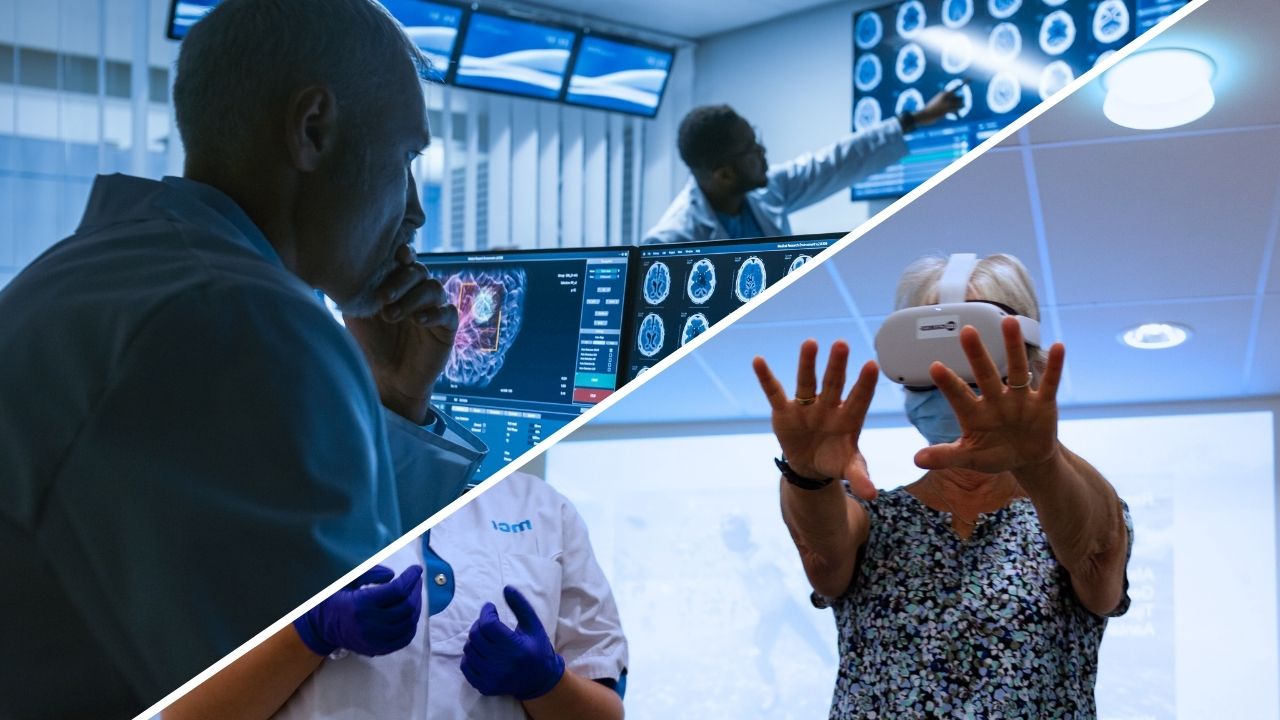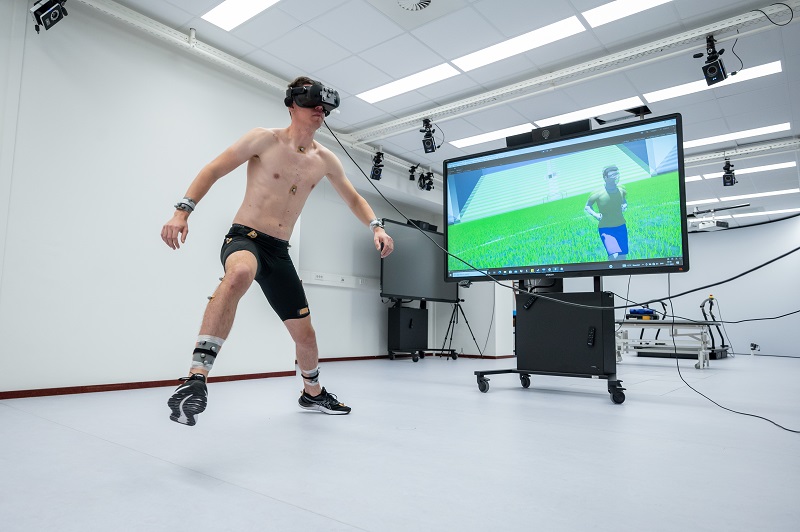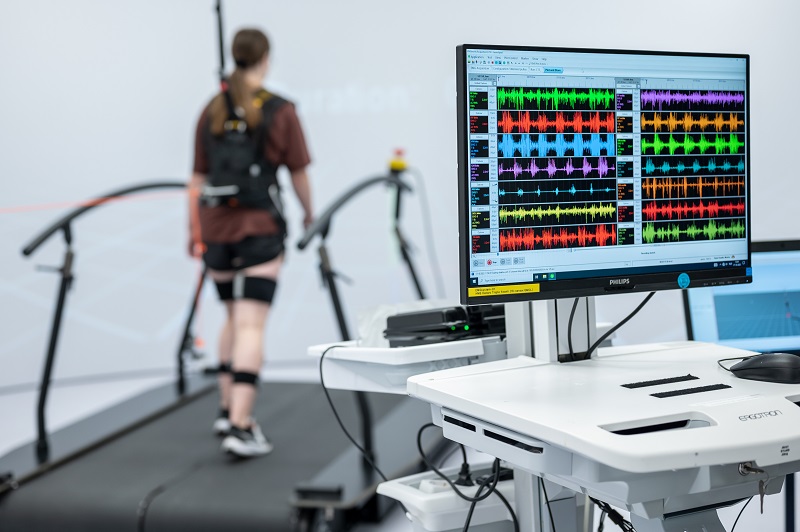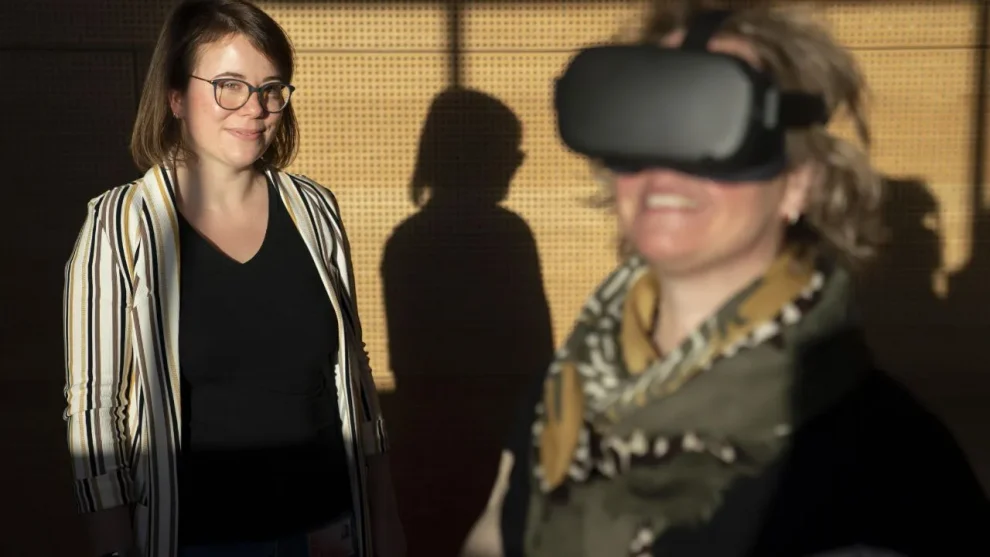What can combining virtual reality with motion capture devices mean for movement sciences? We talked about that with the Human Movement Sciences (HMS) department of the University Medical Center Groningen (UMCG), with whom 8D has been collaborating since the beginning of this year on the development of software for a number of large virtual reality (VR) setups. A wonderful job that – is the ambition – will enable new research in the fields of sports, rehabilitation and aging.
‘The equipment in our movement labs ranges from small activity meters to large setups with the motion capture system Vicon,’ says engineer Wim Kaan, head of Technical Support in the Department of Movement Sciences. ‘Two of our setups have this system as a base. The next step is to develop virtual reality environments that work together with this specialized equipment. In this way we create the possibility for researchers to study issues that cannot be measured in the ‘real’ world, or can be measured poorly, in a realistic setting anyway.’
Applications for movement studies
One of the researchers closely involved in the realization of the setups is Raoul Bongers. Raoul: “The beauty of VR is that the visual information with which we provoke a certain movement – for example, a ball being thrown – can be manipulated very precisely. What happens to the movement of the test subject when the ball is thrown slightly higher or slightly lower? That can be controlled much more precisely in VR than in the real world.’ In addition, a VR setup can solve logistical problems: ‘Think, for example, of testing movements in complex environments with many obstacles. In VR, we can move obstacles suddenly or make them fall over – that makes it possible to study how people adjust their walking patterns to cope with such a disruption.’ The setups can also add a lot of value for adjacent fields and departments. Researcher Anniek Heerschop: ‘Think of looking in detail at the kinematics of a soccer player at injury-prone moments in a match, but also analyzing the viewing behavior of someone crossing a busy road. Or teaching a specific skill or movement in a completely safe environment, for example within elderly care or during a rehabilitation program.’
Building bridges between departments, institutions and companies
HMS aspires to be a global leader in the use of VR setups within exercise science. In addition, the department would like to build lasting relationships with other hospital departments and innovative companies. Kaan: “This is of course on the condition that students and researchers play an active role in developments instigated by companies, so that there is a fruitful interaction between business and science. We see that technical developments are moving at lightning speed. This creates opportunities, but also carries the risk that you don’t give new equipment the chance to really take root – or worse: you are hastily inventing the wheel side by side. That is why we want other departments and innovative organizations to be able to find our lab.
Johan van der Meulen, involved in the project from 8D, praises this approach: ‘Connection between science and business increases the chances of converting scientific knowledge into new products and services that increase the quality of care. We applaud this enormously, because we too still often see that promising innovations for care and research are ultimately not properly implemented. In this case, we are involved for engineering and design, but we are also often and gladly the link between science and market. For example, by advising researchers on how to take their research results further and make social impact with new knowledge. It is great that the UMCG and HMS are also so actively involved in this.’
Building blocks for application development
Kaan knocked on 8D’s door to develop software for the VR setups: ‘We already knew the company from the Skating Game, a balance game they previously developed for the UMCG. At the moment, 8D’s team is working for us on a number of ‘building blocks’ – pieces of software for Unity – that can be combined or modified as desired. The goal is that with these building blocks, researchers and the technical department at HMS will soon be able to independently develop applications for the VR setups. This creates space to properly tailor the use of the setups to specific research goals and requirements, without having to create a completely new application for each research project.’
5 Frequently Asked Questions About Research and Serious Gaming
This article addresses common questions on integrating serious gaming into your research project. Learn how co-creation and iterative processes can improve data collection and increase the chances of your research results benefiting people and society.
Read blog
VRLab-Splitbelt
This is a setup built around a split-belt treadmill that has integrated power plates. The virtual world is projected onto a large semicircular screen. Both screen and a Vicon MoCapSystem are positioned around the treadmill. The system can be integrated with various other systems such as force plates, an EMG measurement system, a Spirometer, an Eyetracker an XSens mocap system etc. Applications for this system are written in DFlow.
VRLab-HMD
This is a setup built around a large room in which subjects can walk around freely. The test subject wears a Head Mounted Display on which the virtual world is projected. A Vicon MoCapSystem is set up around this space. The system can be integrated with various other systems such as force plates, an EMG measurement system, a Spirometer, an Eyetracker an XSens MoCapSystem etc. Applications for this system are written in Unity.
VRLab-CAVE
This is a so-called CAVE setup consisting of three walls and a floor. The virtual world is projected onto the walls and floor. The entire system is again surrounded by a Vicon MoCapSystem. The system can be integrated with various other systems such as an EMG measurement system, a Spirometer, an Eyetracker an XSens MoCap system etc. Applications for this system are written in Unity.
Want to know more about combining research and gaming, both digital and analog?
Get in touch with Johan van der Meulen






